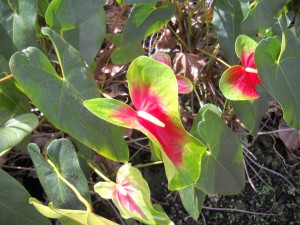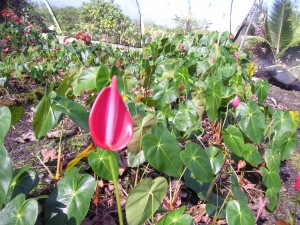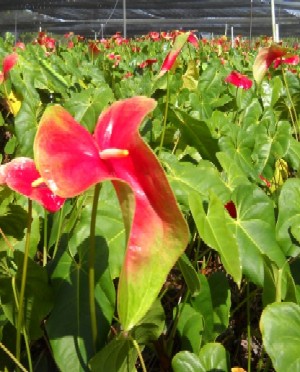How To Plant An Anthurium In A Pot
This is another article in my series of articles on anthurium care. In this article, I will discuss how to plant an anthurium in a pot. If you want to pot an anthurium, there are several things that you need to keep in mind.
First you need to consider the size of the plant that you wish to pot. Is it coming from tissue culture or a top cutting? In general, tissue culture plants are tiny, so you can use a small two inch pot. But if you are taking a top cutting, you could be dealing with a medium to a large plant. So you may need a pot that is anywhere from four inches to twelve inches in size.
Second, you need to use the proper growing media. The most important factor when choosing a growing media is that it drains well. Excess water can allow anaerobic bacteria or fungus to grow. These organisms can kill your plant, so you have to make sure that the growing media does not hold excess water. Anything that adds porosity to your media works. You can use perlite, sand, gravel, wood chips, volcanic cinder or pumice.
Third, now that you have settled on a pot and the growing media, you will need to pot your plant. Take a scoop of growing media and put it on the bottom of the pot. Next, put your plant into the pot and put additional media into the pot, around your plant. Stop once you have filled the pot almost to the brim. Add a small dose of slow release fertilizer and that should do it.
Now that you have finished potting your plant, give it a thorough watering to allow the soil to settle and to hydrate your anthurium. Next, find a bright spot that is out of direct sunlight to put your newly potted anthurium. Finally, make sure that your plant doesn’t get to hot or cold: it is especially vulnerable after being potted. And make sure that you water it regularly.
Obake Anthurium: How To Fertilize An Obake Anthurium
Obake Athuriums produce some of the biggest and most beautiful anthurium flowers. Their flowers are much bigger and wider than regular anthuriums and they are also much more colorful. Usually they will produce flowers that have two or more colors. If you have a prized obake anthurium and you want it to produce the biggest and best flowers that it is capable of producing, this is what you need to do.
Sure, you could take the easy way out and utilize slow release fertilizer, and just apply it twice per year and be done with it. This is simple and easy to do. But this will not enable your plant to live up to its full potential. Doing this will keep it healthy and allow it to produce reasonable flowers.
If you want your plant to produce the best flowers that it is capable of producing, you need to use an approach that takes a lot more work. But if you have a highly prized plant the extra work will be worth it, when you see your plant growing well and producing amazing flowers.
What you need to do is feed it with liquid fertilizer. You will need to dilute the liquid fertilizer to roughly ten percent of the strength recommended on the label and you will need to apply it every week on a consistent basis. Make sure a little fertilizer gets poured on your plant’s leaves and stalk, in addition to its roots, because your plant can absorb nutrition through these areas too.
Watch out if the leaves on your obake anthurium plant turn yellow or brown, as this is a sign that it is getting too much fertilizer. If this happens, flush out the fertilizer with a dose of water and reduce the amount of fertilizer that you are applying. If you follow this routine consistently, your plant will grow faster and produce bigger and better flowers.
Anthurium Fertilizing Frequency
A common question that comes up when discussing anthurium care is: how often should you fertilize your anthurium flowers? The correct answer is that it depends. It depends on the type of soil that you are growing your anthuriums in, the location where you are growing your plant and the type of fertilizer that you are using.
Anthuriums come from the jungles of South America. In their jungle home no one goes around fertilizing them. They obtain all the nutrients that they need from nature and so do not require any artificial fertilizer. So if you are growing them outside, under a shade tree that drops a fair amount of leaves, you probably don’t need to fertilize them at all, as long as you allow the leaves from the tree to decompose around your plants.
If you are growing your plants in pots, whether in doors or outdoors, they will require fertilizer. But the frequency that you fertilize depends on the type of fertilizer that you use.
Slow release fertilizer has a special coating that does exactly what its name implies. It releases nutrients slowly, over a period of time. Each time you water your plant, a little bit of the coating dissolves and this allows nutrients to escape and reach the roots of your plant. It is best to apply slow release fertilizer twice a year.
With liquid fertilizer, the nutrients are released to your plant immediately, so you have to apply it much more often. In general, you should apply it once per week, when you are watering your plant. But you have to make sure that it is diluted to roughly 10% of the strength indicated on the label. Anthuriums don’t need a lot of nutrients and high doses of fertilizer can harm them. It is always better to apply too little fertilizer rather than too much.
Anthurium Care: How To Fertilize An Anthurium
Taking care of an anthurium is easy once you have learned the basics of anthurium care. In previous articles, I have covered where to keep your anthurium and how to water it. In this article I will discuss how to fertilize an anthurium.
Improper fertilization of your plant can kill it, so it is important to learn how to fertilize it correctly. The most important thing to keep in mind is to never over fertilize your plant. If you are uncertain as to how much fertilizer you should give your plant, make sure you give it less than you think it needs. If you over fertilize your plant you can kill it. While, if you under fertilize your plant, the worse that will happen is that it will grow a little slower.
There are two types of fertilizer that can be used to fertilize an anthurium: slow release or liquid. With slow release, you apply it once and don’t have to apply it again for six months. With liquid fertilizer, you will have to apply it every week. In general, I recommend using slow release fertilizer unless you are willing to devote a lot of attention to your plant.
The main thing to look for in a fertilizer is an even ratio of nitrogen, phosphorus and potassium. To find this type of fertilizer, just look at the numbers on the bottle. They should be something like 15-30-15.
Once you have selected a fertilizer, you will need to apply it. To apply it just read the directions on the label and reduce the amounts you see there by 75%. Let’s say that the label says that for 8 inch pots you should apply 1 teaspoon, for an anthurium in an 8 inch pot you should instead apply a quarter teaspoon. As far as application frequency, a slow release fertilizer should be applied once every six months.
Anthurium Plants: How to Keep Them Alive
Anthurium plants are vulnerable to a number of diseases, pests and poor care practices, but overall they are really easy plants to care for. In this article I am going to give you guidelines that will help you to keep your anthurium plant in excellent shape. And of course I am also going to tell you the quickest way to kill an anthurium. This one common mistake is responsible for killing more anthurium plants than all of the other mistakes combined.
The Two Keys Of Anthurium Plant Care
The two most important components of anthurium care is choosing a good location to keep your plant and watering it properly. When it comes to location, temperature, light levels and humidity are all very important aspects. With watering, both too much and too little water can cause major problems. Everything else, including fertilizing, pruning, re-potting and even pest management is secondary. To learn more about these two critical items, please review my article on anthurium care.
Light Levels: A Commonly Overlooked Factor
Light levels are critical to anthurium plants. Too much light and your plants will burn. Too little light and your plants will be stunted. The key is to strike a good balance between these two extremes. In general, you should never put your anthurium in a location that receives strong, direct sunlight. The anthurium is a rain forest dwelling plant and requires weaker, filtered sunlight. You can accomplish this by keeping your plant near a window, but out of direct sunlight or you can put a thin, gauzy curtain over your window to block out a portion of the sun’s rays.
Anthurium Pests And Diseases
When it comes to pests and diseases, you will be pleased to know that if you are only raising a few indoor plants, the majority of the pests and diseases that plague anthurium plants that are grown in a commercial setting will be of no major consequence to you. Thrips, mites, nematodes, white flies and even the deadly Xanthomonas blight should be of little concern to you.
The main disease that you have to watch out for is root rot. This is caused by a fungus that thrives in moist, warm environments. Fortunately, it is easy to prevent this disease. All you have to do is pay attention to how you water your plant. Always make sure that all excess water is allowed to drain away from the roots of your plant and make sure that you wait for the roots to dry slightly before watering again. Assuming you are using a porous potting soil, you can water daily and still meet these two conditions. You can find more detailed information in my article on anthurium pests.
The Biggest Mistake
And finally the biggest mistake you can make with an anthurium plant is very simple and easy to do. I wish that this wasn’t the case, but this one mistake is responsible for killing more anthurium plants than all the other causes combined. And it is forgetting to water your anthurium plant. In the rain forest, these plants receive water on a daily basis. Obviously rain doesn’t fall in your home, so it is up to you to water them. I believe that the best way to remember to water them is to keep them in a location where you see them everyday and just make it a habit to water them everyday at the same time of the day. And remember, if you are watering them on a daily schedule; make sure you have them planted in a potting mix that drains well to avoid root rot.
Anthurium Plant Video
This is a brief video on how to care for a potted anthurium plants. It covers potting, watering and sunlight requirements.
Other Anthurium Care Articles
- How To Fertilize An Anthurium
- How To Prune Your Anthurium Plant
- How To Create The Ideal Potting Soil For Anthuriums
Anthurium Care: How To Care For Anthurium Flowers
Proper anthurium care is easy; for the most part, you only need to address two basic factors to keep your anthurium plants healthy and you only need to avoid making three deadly mistakes to ensure that they stay alive.
The two factors that are vital for ensuring healthy anthurium plants are: the location where your keep your plant and the way in which you water your plant.
Once you have addressed these critical factors, all you have to do is avoid making the three deadly mistakes that I cover below and you will be well on your way to ensuring that your anthurium plants remain healthy.
Best Location For Anthuriums
If you want to keep your anthurium flowers healthy, you have to keep them in the right place. Anthuriums come from South American rainforests and can be harmed if they are not kept in conditions that resemble their ancestral home.
In the rain forest, anthuriums generally encounter temperatures between 70 and 90 degrees and humidity between 80 and 100%, plus they either live on the forest floor or grow on trees and so they are shaded from direct sunlight.
So, first, you have to be sure that your plant is never put in a location that freezes. Frost will kill your plant. Temperatures below 55 degrees are bad for your plant and it should ideally be kept at temperatures above 70 degrees. In addition, your plant should not be allowed to get too hot. Temperatures above 90 degrees are too hot and can also harm your plant.
Second, you have to try to ensure that your plant receives the proper amount of humidity. Humidity between 80 and 100% is ideal. But a little lower is fine as long as you water your plant regularly.
Third, you must make sure that your plant is not exposed to direct sunlight. Direct sunshine can harm its leaves and flowers. However, you do want it to receive a fair amount of light, so that it can grow well.
So, what is the best way to achieve these two conditions? The first thing you can do to ensure that your plant is kept at the proper temperature is to keep it indoors. Assuming that you keep your house between 70 to 90 degrees, your plant will find the temperature agreeable. The second thing you can do give your plant the proper humidity is keep it in the bathroom. When you take a hot shower, you will also be providing plenty of humidity for it. If you don’t want to keep your plant there and you live in a dry climate, consider keeping your plant in a room with a humidifier. Finally, keep it near a window that receives a lot of light, but make sure that it does not receive direct sunshine. If the edges of its leaves are becoming bleached or are turning brown, move it a little further away from the window to prevent them from being burnt by excessive sunlight.
Watering Anthurium Plants
Anthuriums are used to growing in tropical rain forests. The key word in the previous sentence is rain. They are used to receiving water on a daily basis. However, they are not accustomed to standing water. They typically grow on trees. So what happens is rain falls on them and it immediately drips off, it does not pool around their roots. This allows their roots to receive moisture, while also receiving exposure to air. The exposure to air is critical. This prevents the growth of anaerobic organisms that can harm them.
So the key when it comes to watering anthuriums is to water them regularly, while at the same time allowing their roots to receive air.
We can accomplish this by using a good potting soil. The ideal potting soil is light, fluffy and has to drain well. You can use just about anything as long as it meets this last criteria. Everything from sand, perlite, bark, volcanic cinder and gravel can be used to help meet this requirement.
Once you have the proper potting soil nailed down. You have to make sure that the water can drain completely out of the pot. If you have your pot in a tray, you have to make sure that you empty the tray after watering.
Do not overlook the importance of adequate drainage. The deadliest mistake of all is forgetting to water your plants, but arguably the second deadliest mistake is allowing their root system to remain soaked in water. When their roots are left in water, this prevents oxygen from reaching their roots and when this happens anaerobic microbes and fungal growth will occur and cause root rot. Left unchecked root rot will kill your plants.
Finally, we get to the actual watering of your plant. The general rule is water it everyday. As long as your pot drains completely after each watering, it is almost impossible to over-water your plant. If you have the time and live in an area with low humidity, you should also mist the leaves of your plant. Just spritz them with water twice a day.
Fertilizing Anthurium Flowers
Anthuriums need to be fertilized periodically, but you have to be careful not to over-fertilize them. This can be a deadly mistake. When fertilizing your plants, always err on the side of under-fertilizing them. If you give them too little fertilizer, the worse that will happen is that they will grow slower and produce fewer flowers, and if you see this happening you can easily fix this by giving them a little more fertilizer. But if you give them too much fertilizer they can die.
Aim to fertilize them once or twice per year depending on how long the growing season in your region lasts. Use a fertilizer with a ratio of 5-10-5 and apply roughly a quarter of what the label recommends. This ratio is ideal for ensuring a good balance between foliage and flowers. If you were to use a fertilizer with high nitrogen like, 15-10-5, you will get a bunch of leaves but fewer flowers. And when choosing a fertilizer, go for a slow release variety. This way you only have to fertilizer your plants once or twice per year, rather than once a week if you were to use a liquid fertilizer.
Conclusion
In conclusion, anthurium care is simple. Just put your plants in the proper location and water them properly. Avoid the three deadly mistakes of: forgetting to water them, over-fertilizing them and allowing water to collect around their root system; and you will have no problem keeping your anthurium plants in great shape.
Anthurium Care Mini-Course
Are you slowly killing your anthurium plant?
My family and I have been growing anthuriums for over thirty years on the Island of Hawaii. Over the years we have learned a few tips and secrets to anthurium care.
Enter your email and learn things like:
- How to keep your anthurium plant alive
- Ways to avoid pests and diseases
- How to recognize nutrient deficiencies
- The two deadly watering mistakes
- What to do about yellowing leaves
- How to keep the devastating blight away
- What to do if your plant stops flowering
- How to prevent root rot
Enter your email and you will also receive:
Hawaii’s Must-See Destinations:
- Where to see a fully restored Hawaiian village
- How to get the most stunning view of the Hamakua coast
- The name of one of the world’s best beaches
Anthurium Flower Secrets:
- How to make your flowers last up to twice as long
- Tips for weddings and special occasions
- Mistakes to avoid when ordering anthurium flowers







